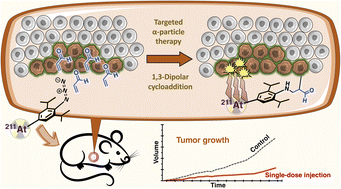Therapeutic efficacy of 211At-radiolabeled 2,6-diisopropylphenyl azide in mouse models of human lung cancer†
Abstract
Targeted α-particle therapy (TAT) is an attractive alternative to conventional therapy for cancer treatment. Among the available radionuclides considered for TAT, astatine-211 (211At) attached to a cancer-targeting molecule appears very promising. Previously, we demonstrated that aryl azide derivatives could react selectively with the endogenous acrolein generated by cancer cells to give a diazo compound, which subsequently forms a covalent bond with the organelle of cancer cells in vivo. Herein, we synthesized 211At-radiolabeled 2,6-diisopropylphenyl azide (ADIPA), an α-emitting molecule that can selectively target the acrolein of cancer cells, and investigated its antitumor effect. Our results demonstrate that a single intratumor or intravenous administration of this simple α-emitting molecule to the A549 (human lung cancer) cell-bearing xenograft mouse model, at a low dose (70 kBq), could suppress tumor growth without inducing adverse effects. Furthermore, because acrolein is generally overproduced by most cancer cells, we believe ADIPA is a simple TAT compound that deserves further investigation for application in animal models and humans with various cancer types and stages.

- This article is part of the themed collections: Most popular 2023 chemical biology articles and 2023 Chemical Science Covers


 Please wait while we load your content...
Please wait while we load your content...